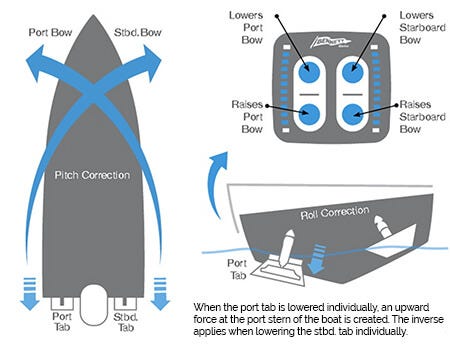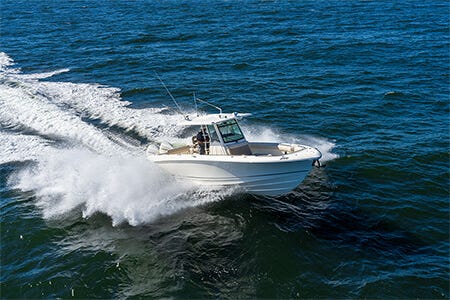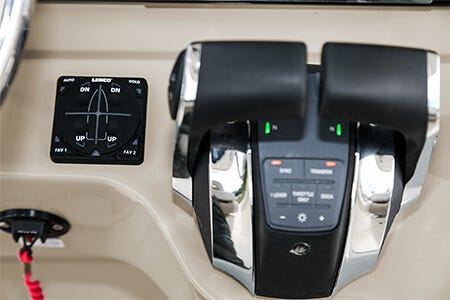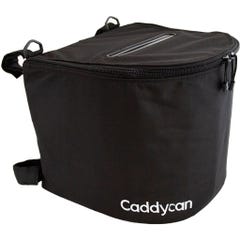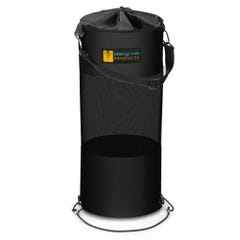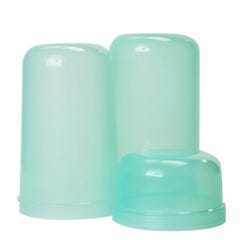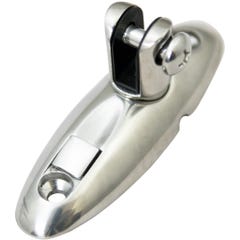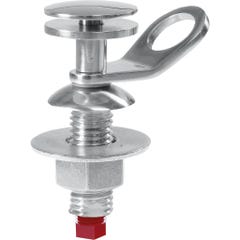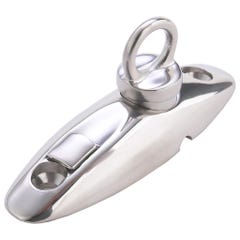Why You Need Trim Tabs: The Many Benefits
January 23, 2024 10 min read


There are a lot of misconceptions around trim tabs that cause people to avoid using them to their full potential or installing them altogether. Early in my boat ownership journey, I remember thinking that trim tabs were only for larger boats. Later, I ran across allusions to them in the context of a poor hull design, and began to associate them with remediation for cheap boat brands. When I got my first power trim and tilt equipped engine, I assumed that the need for trim tabs was eliminated. Somewhere along that journey, there was even a brief moment I thought they would make any boat faster.
Contents
I was dead wrong in all of these assumptions. The fact is that trim tabs can benefit nearly every type of power boat. In effect, these small plates allow you to “flex” your hull design to improve your boat’s performance across a wider range of power, balance and water conditions. Properly used, trim tabs can save gas, smooth out chop and give you and your guests a much more comfortable ride.
Trim Tabs 101
Let’s start with the basics. Trim tabs are generally two stainless steel plates that are mounted on both sides of the stern of the boat. These plates may extend aft of the transom or may be inset into the stern itself. The plates operate on hinges and are powered by either electric or hydraulic actuators, both of which are used to extend the aft portion of the plates downward into the stream of water coursing under your stern. The effect of trim tabs is to raise the stern of the boat, and they can be used independently, allowing you to raise either the starboard or port side of the boat, compensating for imbalance issues or reducing the impact of beam sea conditions.
Trim tabs cannot raise the bow of your boat; they can only raise the stern, which will generally lower the bow.
Trim tabs cannot raise the bow of your boat; they can only raise the stern, which will generally lower the bow. Fully retracted, your boat will behave as if it had no trim tabs at all. Fully deployed while on plane, trim tabs can lead to dangerous “bow steering,” by plowing the bow deep into the water and creating enough drag to potentially cause the stern to attempt to swing around it. Generally, trim tabs should only be fully deployed to get up on plane more quickly, and then retracted as the boat levels out.
What Trim Tabs Do
Trim tabs can be used to correct for specific issues in the way your boat rides, such as listing or porpoising, or they can be used to optimize the boat’s performance. Here are the primary uses of trim tabs:
Stop Porpoising
As a boat accelerates, the hull creates lift, raising the bow further and further out of the water. This dynamic is desirable to a certain extent, since less hull in the water means less drag, leading to better speed and fuel efficiency. However, at some point, the forces lifting the bow are overwhelmed by gravity, which brings the bow back down. As the bow drops, it is supported by the water, reducing the effective weight, and the forces raising it take over again.
This cyclical bouncing is referred to as “porpoising,” and it is both inefficient fuel-wise and uncomfortable for passengers. Trim tabs can eliminate porpoising by reducing bow lift to an optimal state where the hull generates minimal drag but doesn’t experience speed-robbing oscillations.
Correct Listing
Listing refers to a boat’s tilting or leaning to one side. This can be caused by port/starboard weight imbalance, prop torque or even hull defects. When a hull is not properly oriented on its centerline, it does not operate efficiently, track properly or ride as smoothly through chop.
Deploying one trim tab slightly can raise the low side of the boat and put it back on its centerline, leading to happy marriages and better fuel efficiency.
While this issue can often be addressed by re-distributing weight, that option is not always realistic or appropriate. Telling your girlfriend or wife that she is too heavy to sit where she wants to is a good way to wind up swimming back to the dock — and don’t ask me how I know. Trim tabs can diplomatically address listing issues by counteracting the imbalance. Deploying one trim tab slightly can raise the low side of the boat and put it back on its centerline, leading to happy marriages and better fuel efficiency.
Eat Chop
Most hulls have a more aggressive “V” shape at the bow than they do as you move further aft. When on plane, raising the bow reduces drag but doing so also puts the entry point further aft where the hull has a less “V” shape (deadrise). In calm waters, this is the right orientation for a boat, but in choppy conditions, this can lead to a rough, and often wet, ride.
Trim tabs allow you to raise the stern and, in effect, lower the bow so that the more aggressive “V” shape cuts into the chop and smooths out the ride.
Trim tabs allow you to raise the stern and, in effect, lower the bow so that the more aggressive “V” shape cuts into the chop and smooths out the ride. In larger swells or even when crossing boat wakes, this technique can greatly reduce the amount of bouncing your passengers experience and ultimately reduce the impact on your hull.
Improve Hole Shot
One of the most inefficient and hazardous moments for a boat is when it is getting on plane. For most boats, as throttle is increased, the bow rises and eventually, the stern follows until the boat is riding higher in the water column. Depending on hull design, load, and relative power, this process can take quite a bit of time.
Your boat will get on plane more quickly, and keep your propeller operating at a shallower depth and more efficient angle.
During this time, the captain’s visibility is greatly reduced by the orientation of the bow — a dangerous situation in crowded waterways. The boat is also burning fuel at a high rate, but still moving very slowly. In shallow water situations, this can be particularly problematic, since the stern, and ultimately propeller, are driven deeper to compensate for the weight of the bow being raised. Without proper depth, the lower unit, propellers, or rudders can be driven into the bottom.
Trim tabs can solve all of these issues by dramatically quickening and dampening the transition to plane. Fully extended, trim tabs will raise the stern and keep the bow from raising more than it needs to. Your boat will get on plane at a more comfortable angle for your passengers, do so more quickly, and keep your propeller operating at a shallower depth and more efficient angle. Once the boat gets on plane, trim tabs should be retracted quickly to keep them from burying the bow and getting into a bow steering situation.
Minimize Spray
We’ve already seen how deploying both trim tabs can help when heading into choppy conditions, but when the chop is coming from the side of a boat, it can generate uncomfortable spray on the windward side of the hull. Deploying both trim tabs in these situations can actually make the situation worse by lowering the entry point of the bow and moving the source of the spray forward.
In beam seas, trim tabs can greatly reduce the spray by deploying the windward tab more than the leeward tab.
In beam seas, trim tabs can greatly reduce the spray by deploying the windward tab more than the leeward tab. This, in effect, lowers the leeward side of the boat and raises the windward side, which moves the source of the spray aft and uses the hull to block it. Passengers in the back of the boat may still get a little wet, but the amount of spray will be greatly reduced.
Tips for Using Your Trim Tabs
Once you understand how trim tabs can help your boat operate more efficiently and comfortably, the next step is knowing how to use the trim tabs to achieve your objective. There are a few tips that will make you look like an expert.
Tap, Don’t Press
When it comes to using your trim tabs, think “tap dance,” not “bench press.” One of the most common mistakes that most first-time users make with trim tabs is over deploying them. When a boat is on plane, even the smallest trim tab movements can have a dramatic impact on the boat’s behavior.
When a boat is on plane, even the smallest trim tab movements can have a dramatic impact on the boat’s behavior.
Experience captains know to “tap” the trim tab controls, not to press or hold them. In most cases, several short taps will lead to a far better outcome than single, longer applications. The exception here would be when using your tabs to get on plane. In this situation, you are fully deploying the tabs before throttling up, and you are almost fully retracting them as the boat gets on plane.
It’s a Partnership
If your engine has power trim and tilt, this feature can be used to compliment your trim tabs. An engine’s trim has the opposite effect of trim tabs. As discussed, trim tabs raise the stern, in effect dropping the bow, but they cannot raise the bow beyond what the hull would naturally do. Fully retracted, they don’t raise the bow, they just return the hull to its normal “tab-free” orientation.
Think of trim tabs and power trim as extensions of each other, broadening the spectrum of how your boat is oriented against the surface of the water.
Trimming your outboard or outdrive upward has the opposite effect. By trimming the direction of thrust upward, you are lowering the stern and ultimately raising the bow. You can almost think of trim tabs and power trim as extensions of each other, broadening the spectrum of how your boat is oriented against the surface of the water.
When getting on plane, your engine should be trimmed fully down, along with your trim tabs to keep the bow as low as possible through the transition. As the boat gets on plane, the trim tabs should be retracted, and the motor trimmed up to get as much of the hull out of the water as conditions allow. At some point, the boat will begin porpoising, and you will back off of the trim — and potentially deploy trim tabs — to achieve the optimal attitude.
Using Trim and Tabs Together
Only in rare cases will you use both the trim and the tabs simultaneously. In some cases, deploying trim tabs slightly while tilting the motor up can generate more speed by moving more of the hull out of the water. In effect, the boat is riding on its extended tabs, which would normally generate significant drag, but this incremental drag is offset by getting more of the hull out of the water. Typically, this situation is limited to smaller boats with much higher power-to-weight ratios, like bass boats and racing applications.
Deploying trim tabs slightly and tilting the engine up to the point just before cavitation can get you across a sandbar that you would otherwise hit.
Another rare situation where tabs and trim can be used together is in extremely shallow situations where every inch matters. In these situations, deploying trim tabs slightly and tilting the engine up to the point just before cavitation can get you across a sandbar that you would otherwise hit. Not only is the hull riding higher in the water, the engine is tilted up at an angle, reducing the operating depth. Keep in mind that, in these situations, steering and boat handling can be greatly impacted, so caution should be taken. Attempting this in water that is too shallow to be navigated can lead to significant damage to the engine, boat and even passengers — and don’t ask me how I know about that, either.
While trim tabs are more common on larger vessels, they can benefit nearly any kind of hull. The biggest limiting factor is the complexity and weight they add vs. the benefit they provide. While they can improve the overall performance of even the smallest Jon boat, the wiring, switches, actuators or pumps may add more weight and complexity than the value they provide. For most center console boats, however, trim tabs can greatly increase the comfort, efficiency, and performance of your hull.

